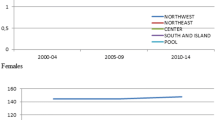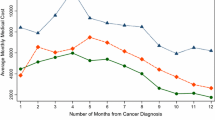Abstract
The etiology of male breast cancer is largely unknown, reflecting its relative rarity. Although a number of previous studies have suggested relationships with a variety of medical conditions, the results have largely derived from case–control studies and may reflect recall biases. Within the large U.S. Veterans Affairs computerized medical care system database, we had the opportunity to access 26 million hospital discharge records over the period 1969–1996 and to relate various documented medical conditions to the risk of subsequent male breast cancer. This allowed us to calculate relative risks (RR) and 95% confidence intervals (CI) for male breast cancer associated with conditions occurring one or more years after initial hospitalization, adjusted for age, race, calendar year, duration of follow-up, and number of hospital visits. Among 4,501,578 men aged 18–100 years, a total of 642 cases of primary male breast cancer were identified (523 among whites, 119 among blacks). Medical conditions that were significantly related to risk were diabetes (RR 1.30, 95% CI 1.05–1.60), obesity (1.98, 1.55–2.54), orchitis/epididymitis (1.84, 1.10–3.08), Klinefelter syndrome (29.64, 12.26–71.68), and gynecomastia (5.86, 3.74–9.17). Additionally, among black patients, cholelithiasis emerged as a significant risk predictor (3.45, 1.59–7.47). Diseases that have previously been related to male breast cancer risk that were not supported by our study results included thyroid diseases, smoking-related conditions, liver cirrhosis, prostatic hyperplasia, and fractures. After adjustment for obesity, the association with diabetes disappeared, but that with gynecomastia persisted. In multivariate models that simultaneously considered all important medical predictors of risk, significant risks were seen for Klinefelter syndrome (16.83, 6.81–41.62), gynecomastia (5.08, 3.21–8.03), obesity (1.91, 1.50–2.44), and orchitis/epididymitis (1.80, 1.08–3.01). These results support previous speculations that male breast cancer is influenced not only by tissue at risk, but also by hormonal and inflammatory factors.
Similar content being viewed by others
References
Jemal A, Siegel R, Ward E, Hao Y, Xu J, Murray T, Thun MJ (2008) Cancer statistics, 2008. CA Cancer J Clin 58(2):71–96. doi:10.3322/CA.2007.0010
Anderson WF, Althuis MD, Brinton LA, Devesa SS (2004) Is male breast cancer similar or different than female breast cancer? Breast Cancer Res Treat 83(1):77–86. doi:10.1023/B:BREA.0000010701.08825.2d
Goodman MT, Tung KH, Wilkens LR (2006) Comparative epidemiology of breast cancer among men and women in the US, 1996 to 2000. Cancer Causes Control 17(2):127–136. doi:10.1007/s10552-005-5384-y
Hultborn R, Hanson C, Kopf I, Verbiene I, Warnhammar E, Weimarck A (1997) Prevalence of Klinefelter’s syndrome in male breast cancer patients. Anticancer Res 17(6D):4293–4297. doi:10.1093/jnci/djn329
Swerdlow AJ, Schoemaker MJ, Higgins CD, Wright AF, Jacobs PA (2005) Cancer incidence and mortality in men with Klinefelter syndrome: a cohort study. J Natl Cancer Inst 97(16):1204–1210. doi:10.1093/jnci/dji240
Brinton LA, Richesson DA, Gierach GL, Lacey JV Jr, Park Y, Hollenbeck AR, Schatzkin A (2008) Prospective evaluation of risk factors for male breast cancer. J Natl Cancer Inst 100(20):1477–1481. doi:10.1093/jnci/djn329
D’Avanzo B, La VC (1995) Risk factors for male breast cancer. Br J Cancer 71(6):1359–1362. doi:10.1080/02841860117406
Ewertz M, Holmberg L, Tretli S, Pedersen BV, Kristensen A (2001) Risk factors for male breast cancer—a case–control study from Scandinavia. Acta Oncol 40(4):467–471. doi:10.1080/028418601750288181
Hsing AW, McLaughlin JK, Cocco P, Co Chien HT, Fraumeni JF Jr (1998) Risk factors for male breast cancer (United States). Cancer Causes Control 9(3):269–275. doi:10.1023/A:1008869003012
Johnson KC, Pan S, Mao Y (2002) Risk factors for male breast cancer in Canada, 1994–1998. Eur J Cancer Prev 11(3):253–263. doi:10.1097/00008469-200206000-00009
Thomas DB, Jimenez LM, McTiernan A, Rosenblatt K, Stalsberg H, Stemhagen A, Thompson WD, Curnen MG, Satariano W, Austin DF (1992) Breast cancer in men: risk factors with hormonal implications. Am J Epidemiol 135(7):734–748
Lenfant-Pejovic MH, Mlika-Cabanne N, Bouchardy C, Auquier A (1990) Risk factors for male breast cancer: a Franco–Swiss case–control study. Int J Cancer 45(4):661–665. doi:10.1002/ijc.2910450415
Sorensen HT, Friis S, Olsen JH, Thulstrup AM, Mellemkjaer L, Linet M, Trichopoulos D, Vilstrup H, Olsen J (1998) Risk of breast cancer in men with liver cirrhosis. Am J Gastroenterol 93(2):231–233
Guenel P, Cyr D, Sabroe S, Lynge E, Merletti F, Ahrens W, Baumgardt-Elms C, Menegoz F, Olsson H, Paulsen S, Simonato L, Wingren G (2004) Alcohol drinking may increase risk of breast cancer in men: a European population-based case–control study. Cancer Causes Control 15(6):571–580. doi:10.1023/B:CACO.0000036154.18162.43
Keller AZ (1967) Demographic, clinical and survivorship characteristics of males with primary cancer of the breast. Am J Epidemiol 85(2):183–199
Olsson H, Ranstam J (1988) Head trauma and exposure to prolactin-elevating drugs as risk factors for male breast cancer. J Natl Cancer Inst 80(9):679–683. doi:10.1093/jnci/80.9.679
Boyko EJ, Koepsell TD, Gaziano JM, Horner RD, Feussner JR (2000) US department of Veterans Affairs medical care system as a resource to epidemiologists. Am J Epidemiol 151(3):307–314
Lynch HT, Watson P, Narod SA (1999) The genetic epidemiology of male breast carcinoma. Cancer 86(5):744–746. doi:10.1002/(SICI)1097-0142(19990901)86:5<744::AID-CNCR4>3.0.CO;2-G
Mies R, Fischer H, Pfeiff B, Winkelmann W, Wurz H (1982) Klinefelter’s syndrome and breast cancer. Andrologia 14(4):317–321
Weiss JR, Moysich KB, Swede H (2005) Epidemiology of male breast cancer. Cancer Epidemiol Biomarkers Prev 14(1):20–26. doi:10.1158/1055-9965.EPI-05-0414
Paduch DA, Fine RG, Bolyakov A, Kiper J (2008) New concepts in Klinefelter syndrome. Curr Opin Urol 18(6):621–627. doi:10.1097/MOU.0b013e32831367c7
de Bree E, Tsagkatakis T, Kafousi M, Tsiftsis DD (2005) Breast enlargement in young men not always gynaecomastia: breast cancer in a 22-year-old man. ANZ J Surg 75(10):914–916. doi:10.1111/j.1445-2197.2005.03572
Goss PE, Reid C, Pintilie M, Lim R, Miller N (1999) Male breast carcinoma: a review of 229 patients who presented to the Princess Margaret Hospital during 40 years: 1955–1996. Cancer 85(3):629–639. doi:10.1002/(SICI)1097-0142(19990201)85:3<629:AID-CNCR13>3.0.CO;2-V
Yildirim E, Berberoglu U (1998) Male breast cancer: a 22-year experience. Eur J Surg Oncol 24(6):548–552. doi:10.1016/S0748-7983(98)93608-3
Sasco AJ, Lowenfels AB, Pasker-de JP (1993) Review article: epidemiology of male breast cancer. A meta-analysis of published case–control studies and discussion of selected aetiological factors. Int J Cancer 53(4):538–549. doi:10.1002/ijc.2910530403
Travis RC, Key TJ, Allen NE, Appleby PN, Roddam AW, Rinaldi S, Egevad L, Gann PH, Rohrmann S, Linseisen J, Pischon T, Boeing H, Johnsen NF, Tjonneland A, Overvad K, Kiemeney L, Bueno-de-Mesquita HB, Bingham S, Khaw KT, Tumino R, Sieri S, Vineis P, Palli D, Quiros JR, Ardanaz E et al (2007) Serum androgens and prostate cancer among 643 cases and 643 controls in the European prospective investigation into cancer and nutrition. Int J Cancer 121(6):1331–1338. doi:10.1002/ijc.22814
Vermeulen A, Goemaere S, Kaufman JM (1999) Testosterone, body composition and aging. J Endocrinol Invest 22(5 Suppl):110–116
Wu AH, Whittemore AS, Kolonel LN, John EM, Gallagher RP, West DW, Hankin J, Teh CZ, Dreon DM, Paffenbarger RS Jr (1995) Serum androgens and sex hormone-binding globulins in relation to lifestyle factors in older African–American, white, and Asian men in the United States and Canada. Cancer Epidemiol Biomarkers Prev 4(7):735–741
Bjornerem A, Straume B, Midtby M, Fonnebo V, Sundsfjord J, Svartberg J, Acharya G, Oian P, Berntsen GK (2004) Endogenous sex hormones in relation to age, sex, lifestyle factors, and chronic diseases in a general population: the Tromso Study. J Clin Endocrinol Metab 89(12):6039–6047. doi:10.1210/jc.2004-0735
Greendale GA, Edelstein S, Barrett-Connor E (1997) Endogenous sex steroids and bone mineral density in older women and men: the Rancho Bernardo Study. J Bone Miner Res 12(11):1833–1843. doi:10.1359/jbmr.1997.12.11.1833
Vermeulen A, Kaufman JM, Goemaere S, van Pottelbergh I (2002) Estradiol in elderly men. Aging Male 5(2):98–102. doi:10.1080/713604678
Rice D, Brannigan RE, Campbell RK, Fine S, Jack L Jr, Nelson JB, Regan-Klich J (2008) Men’s health, low testosterone, and diabetes: individualized treatment and a multidisciplinary approach. Diabetes Educ 34(Suppl 5):97S–112S. doi:10.1177/0145721708327143
Allen NE, Key TJ (2000) The effects of diet on circulating sex hormone levels in men. Nutr Res Rev 13(2):159–184. doi:10.1079/095442200108729052
Weiderpass E, Ye W, Adami HO, Vainio H, Trichopoulos D, Nyren O (2001) Breast cancer risk in male alcoholics in Sweden. Cancer Causes Control 12(7):661–664. doi:10.1023/A:1011216502678
Rosenblatt KA, Thomas DB, Jimenez LM, Fish B, McTiernan A, Stalsberg H, Stemhagen A, Thompson WD, Curnen MG, Satariano W, Austin DF, Greenberg RS, Key C, Kolonel LN, West DW (1999) The relationship between diet and breast cancer in men (United States). Cancer Causes Control 10(2):107–113. doi:10.1023/A:1008808925665
Casagrande JT, Hanisch R, Pike MC, Ross RK, Brown JB, Henderson BE (1988) A case–control study of male breast cancer. Cancer Res 48(5):1326–1330
Mabuchi K, Bross DS, Kessler II (1985) Risk factors for male breast cancer. J Natl Cancer Inst 74(2):371–375
Petridou E, Giokas G, Kuper H, Mucci LA, Trichopoulos D (2000) Endocrine correlates of male breast cancer risk: a case–control study in Athens, Greece. Br J Cancer 83(9):1234–1237. doi:10.1054/bjoc.2000.1467
Lee UJ, Jones JS (2009) Incidence of prostate cancer in male breast cancer patients: a risk factor for prostate cancer screening. Prostate Cancer Prostatic Dis 12(1):52–56. doi:10.1038/pcan.2008.26
Thellenberg C, Malmer B, Tavelin B, Gronberg H (2003) Second primary cancers in men with prostate cancer: an increased risk of male breast cancer. J Urol 169(4):1345–1348. doi:10.1097/01.ju.0000056706.88960.7c
Novacek G (2006) Gender and gallstone disease. Wien Med Wochenschr 156(19–20):527–533. doi:10.1007/s10354-006-0346-x
Andreotti G, Chen J, Gao YT, Rashid A, Chang SC, Shen MC, Wang BS, Han TQ, Zhang BH, Danforth KN, Althuis MD, Hsing AW (2008) Serum lipid levels and the risk of biliary tract cancers and biliary stones: a population-based study in China. Int J Cancer 122(10):2322–2329. doi:10.1002/ijc.23307
Acknowledgments
This study was supported in part by funds from the intramural program of the National Cancer Institute, National Institutes of Health. We are indebted to Eric Boyd of IMS in Rockville, MD for assistance with computer programming.
Author information
Authors and Affiliations
Corresponding author
Rights and permissions
About this article
Cite this article
Brinton, L.A., Carreon, J.D., Gierach, G.L. et al. Etiologic factors for male breast cancer in the U.S. Veterans Affairs medical care system database. Breast Cancer Res Treat 119, 185–192 (2010). https://doi.org/10.1007/s10549-009-0379-0
Received:
Accepted:
Published:
Issue Date:
DOI: https://doi.org/10.1007/s10549-009-0379-0




